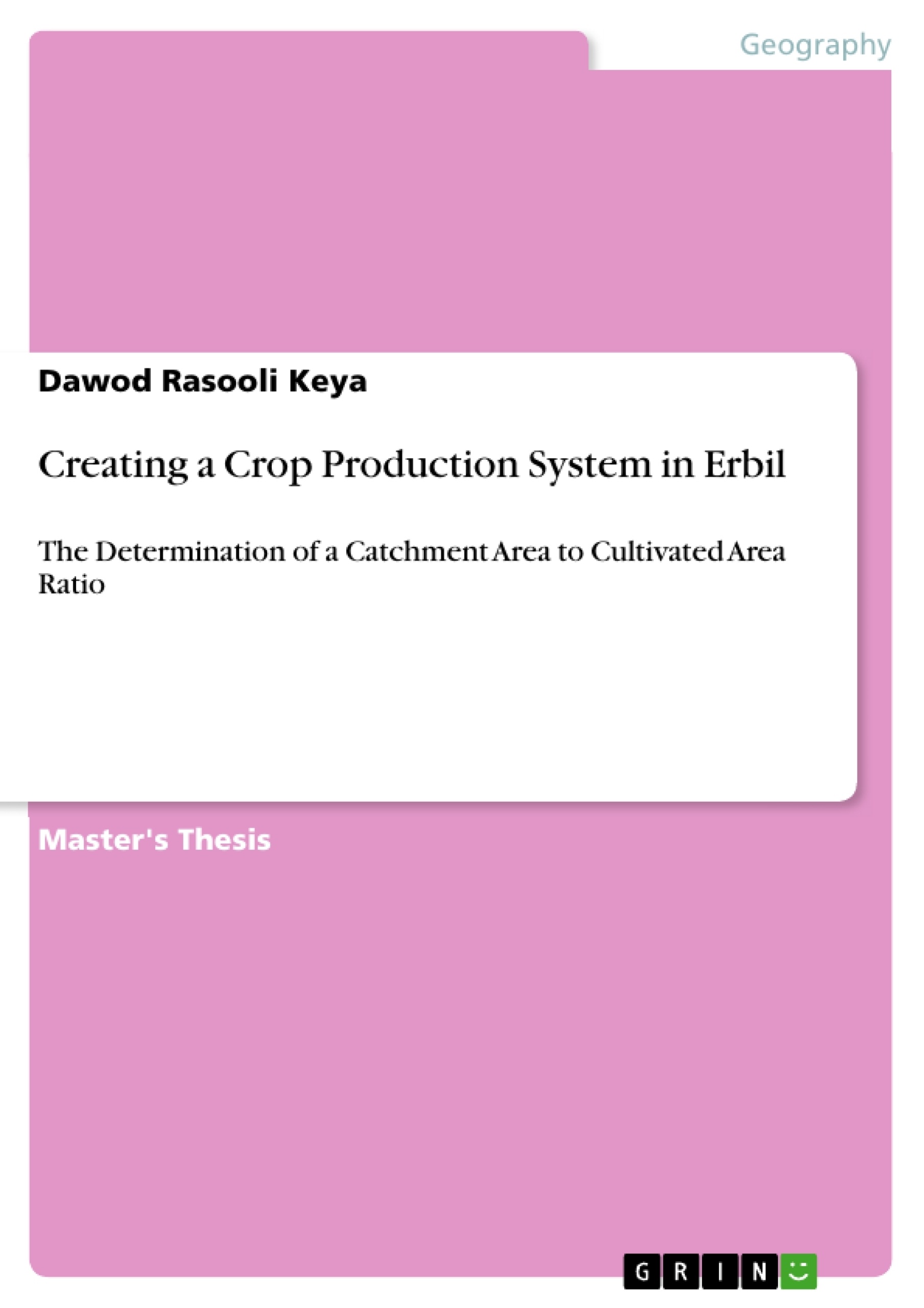
Creating a Crop Production System in Erbil
Masterarbeit, 2009
202 Seiten, Note: 90.0
Geowissenschaften / Geographie - Phys. Geogr., Geomorphologie, Umweltforschung
Leseprobe
Inhaltsverzeichnis (Table of Contents)
- Summary
- List of Contents
- List of Tables
- List of Figures
- List of Appendixes
- 1 Introduction
- 2 Literature Review
- 2.1 General
- 2.2 Water harvesting advantages and disadvantages
- 2.2.1 Advantages
- 2.2.2 Disadvantages
- 2.3 Historical perspectives
- 2.3.1 Historical perspectives all over the world
- 2.3.2 Water harvesting in Iraq
- 2.3.3 Water harvesting in Iraqi Kurdistan Region
- 2.4 Water harvesting components
- 2.5 Types of water harvesting
- 2.6 Kind of storage
- 2.6.1 Above-ground water storage
- 2.6.2 Underground storage
- 2.7 Runoff strips
- 2.8 Main design parameters for water harvesting
- 2.8.1 Main design parameters for microcatchments water harvesting
- 2.8.2 Main design parameters for macrocatchment and floodwater
- 2.9 Parameters which must be considered to select the most suitable area for water harvesting
- 2.9.1 Rainfall
- 2.9.2 Soil factor
- 2.9.3 Topography
- 2.9.4 Hydrology and water resources
- 2.9.5 Socio economic conditions
- 2.9.6 Environmental and ecological impacts
- 2.9.8 Costs
- 2.10 Design models for catchments cultivated area ratio
- 2.11 Crop production systems
- 2.11.1 Crop production systems
- 2.11.2 Systems for row crops
- 2.11.3 Systems for trees
- 2.11.4 Systems for Rangeland and fodder
- 2.12 Factors affecting Runoff
- 2.12.1 Rainfall event characteristics
- 2.12.2 Soil type
- 2.12.3 Vegetative cover
- 2.12.4 Land slope
- 2.12.5 Catchment size
- 2.12.6 Antecedent water content
- 2.12.7 Other considerations
- 2.13 Threshold value
- 2.14 Runoff Measurement
- 2.14.1 Runoff plots
- 2.14.2 Volumetric method
- 2.14.3 Velocity area method
- 2.14.4 Rating a gauging station
- 2.14.5 Gauging structures
- 2.14.6 Water level records
- 2.15 Estimating runoff
- 2.15.1 Maximum runoff rates
- 2.15.2 Runoff quantity or yield
- 2.15.2.1 USDA-SCS (1964) method
- 2.15.2.2 Infiltration method
- 2.15.2.3 Empirical formula
- 2.16 Runoff inducement
- 2.16.1 Mechanical treatment
- 2.16.2 Chemical treatments
- 2.16.2.1 Sodium salts
- 2.16.2.2 Paraffin wax
- 2.16.2.3 Silicon
- 2.16.2.4 Crude oil
- 2.16.2.5 Other chemicals
- 2.16.3 Flexible membranes
- 2.16.4 Rigid membranes
- 3 Materials and Methods
- 4 Results and Discussion
- 5 Conclusion
- 6 Recommendation for future works
Zielsetzung und Themenschwerpunkte (Objectives and Key Themes)
The main objective of this thesis is to determine the optimal catchment to cultivated area ratio for crop production systems in the Erbil Governorate, a semi-arid region of Iraq. This involves investigating the effects of various soil treatments on runoff inducement under both natural and simulated rainfall conditions. The study also aims to design a rainfall simulator that accurately replicates the characteristics of natural rainfall in the region.
- Rainfall characteristics in Erbil and their impact on runoff.
- Effectiveness of different soil treatments in inducing runoff.
- Determination of the optimal catchment to cultivated area ratio for selected winter crops.
- The influence of catchment to cultivated area ratio on crop growth and yield.
- Water quality of runoff water from different soil treatments.
Zusammenfassung der Kapitel (Chapter Summaries)
Chapter One: Introduction: This chapter introduces the problem of water scarcity in arid and semi-arid regions and highlights the importance of rainwater harvesting as a sustainable water management strategy. It emphasizes the significance of determining the appropriate catchment to cultivated area ratio for efficient crop production. The chapter outlines the study's objectives, focusing on rainfall characterization, the impact of soil treatments on runoff inducement, and the estimation of the optimal catchment to cultivated area ratio for selected winter crops in Erbil.
Chapter Two: Literature Review: This chapter provides a comprehensive overview of existing literature on water harvesting techniques, encompassing historical perspectives from various regions worldwide, including Iraq and the Kurdistan region. It details the advantages and disadvantages of water harvesting, the components of water harvesting systems, different types of water harvesting methods, and the factors influencing runoff, such as rainfall characteristics, soil properties, vegetation cover, and land slope. The chapter also explores various runoff inducement techniques, including mechanical and chemical treatments and the use of different membranes.
Chapter Three: Materials and Methods: This chapter describes the materials and methods used in the study. It details the procedures for determining design rainfall depth, measuring raindrop size and terminal velocity, establishing runoff plots, and conducting rainfall simulation experiments using a specially designed rainfall simulator. The chapter also outlines the methods used for soil analysis and statistical analysis of the collected data.
Schlüsselwörter (Keywords)
Rainwater harvesting, runoff inducement, catchment area, cultivated area, crop production, soil treatment, rainfall simulation, Erbil Governorate, Iraq, semi-arid region, winter crops, wheat yield, runoff coefficient, soil moisture, water quality.
Häufig gestellte Fragen
What is the main topic of this document?
This document provides a language preview for a research paper or thesis focusing on water harvesting in the Erbil Governorate of Iraq. It includes the table of contents, objectives, key themes, chapter summaries, and keywords.
What is the purpose of this research, according to the objectives?
The main objective is to determine the optimal catchment to cultivated area ratio for crop production systems in the Erbil Governorate, a semi-arid region of Iraq. The research investigates the effect of various soil treatments on runoff inducement and involves designing a rainfall simulator.
What key themes are explored in this research?
The key themes include rainfall characteristics in Erbil and their impact on runoff, the effectiveness of different soil treatments in inducing runoff, determining the optimal catchment to cultivated area ratio for selected winter crops, the influence of this ratio on crop growth and yield, and the water quality of runoff from different soil treatments.
What does Chapter One cover?
Chapter One (Introduction) introduces the problem of water scarcity in arid and semi-arid regions, emphasizes the importance of rainwater harvesting, and outlines the study's objectives: rainfall characterization, the impact of soil treatments on runoff inducement, and estimating the optimal catchment to cultivated area ratio for winter crops in Erbil.
What does Chapter Two cover?
Chapter Two (Literature Review) provides an overview of water harvesting techniques, including historical perspectives, advantages and disadvantages, components of water harvesting systems, different types of methods, and factors influencing runoff (rainfall, soil, vegetation, slope). It also explores runoff inducement techniques.
What does Chapter Three cover?
Chapter Three (Materials and Methods) describes the materials and methods used in the study, including procedures for determining design rainfall depth, measuring raindrop size, establishing runoff plots, conducting rainfall simulation experiments, soil analysis, and statistical analysis.
What keywords are associated with this research?
The keywords include: Rainwater harvesting, runoff inducement, catchment area, cultivated area, crop production, soil treatment, rainfall simulation, Erbil Governorate, Iraq, semi-arid region, winter crops, wheat yield, runoff coefficient, soil moisture, water quality.
What does the table of contents include?
The table of contents includes a summary, list of contents, tables, figures, appendixes, introduction, literature review (covering various subtopics related to water harvesting), materials and methods, results and discussion, conclusion, and recommendations for future works.
Details
- Titel
- Creating a Crop Production System in Erbil
- Untertitel
- The Determination of a Catchment Area to Cultivated Area Ratio
- Hochschule
- Salahaddin University (Agriculture College)
- Note
- 90.0
- Autor
- Dawod Rasooli Keya (Autor:in)
- Erscheinungsjahr
- 2009
- Seiten
- 202
- Katalognummer
- V509512
- ISBN (eBook)
- 9783346109316
- ISBN (Buch)
- 9783346109323
- Sprache
- Englisch
- Schlagworte
- creating cultivated area catchment determination erbil system production crop ratio
- Produktsicherheit
- GRIN Publishing GmbH
- Preis (Ebook)
- US$ 0,99
- Preis (Book)
- US$ 53,99
- Arbeit zitieren
- Dawod Rasooli Keya (Autor:in), 2009, Creating a Crop Production System in Erbil, München, Page::Imprint:: GRINVerlagOHG, https://www.diplomarbeiten24.de/document/509512
- Autor werden
- Ihre Optionen
- Vertriebskanäle
- Premium Services
- Autorenprofil
- Textarten und Formate
- Services für Verlage, Hochschulen, Unternehmen

- © GRIN Publishing GmbH.
- Alle Inhalte urheberrechtlich geschützt. Kopieren und verbreiten untersagt.
- info@grin.com
- AGB
- Open Publishing
Der GRIN Verlag hat sich seit 1998 auf die Veröffentlichung akademischer eBooks und Bücher spezialisiert. Der GRIN Verlag steht damit als erstes Unternehmen für User Generated Quality Content. Die Verlagsseiten GRIN.com, Hausarbeiten.de und Diplomarbeiten24 bieten für Hochschullehrer, Absolventen und Studenten die ideale Plattform, wissenschaftliche Texte wie Hausarbeiten, Referate, Bachelorarbeiten, Masterarbeiten, Diplomarbeiten, Dissertationen und wissenschaftliche Aufsätze einem breiten Publikum zu präsentieren.
Kostenfreie Veröffentlichung: Hausarbeit, Bachelorarbeit, Diplomarbeit, Dissertation, Masterarbeit, Interpretation oder Referat jetzt veröffentlichen!
- GRIN Verlag GmbH
-
- Nymphenburger Str. 86
- 80636
- Munich, Deutschland
- +49 89-550559-0
- +49 89-550559-10
- info@grin.com
-









